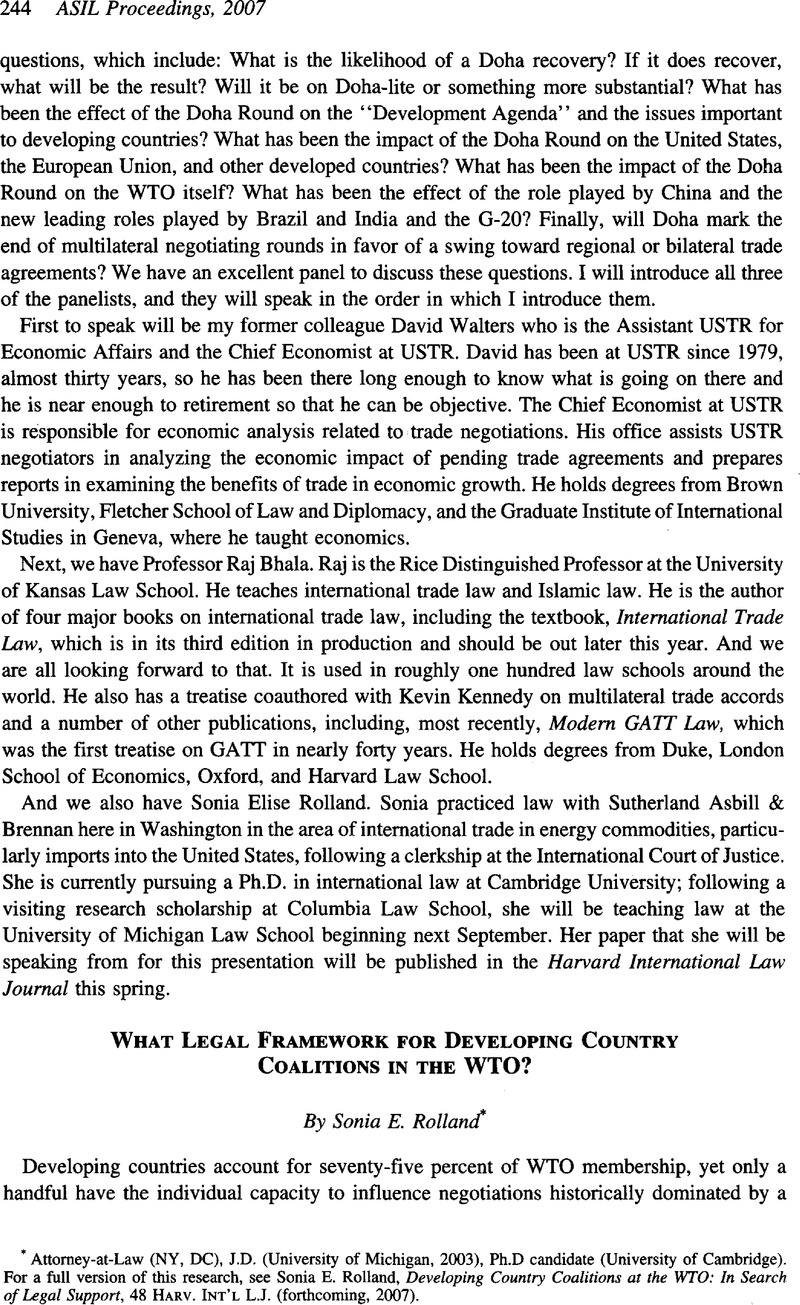Published online by Cambridge University Press: 28 February 2017

1 See generally Amrita Narlikar, International Trade and Developing Countries—Bargaining Coalitions in the Gatt & WTO (2005).
2 Keohane, Robert O. & Nye, Joseph S. Transgovernmental Relations and International Organizations, 27 World Pol. 39, 52 (1974)CrossRefGoogle Scholar.
3 The United Nations defined the category of LDCs in 1971. Yugoslavia, and later the Informal Group of Developing Countries, proposed that the group be recognized in the GATT, as well, and given special legal treatment, which came about with the 1979 Enabling Clause. This process illustrates how a coalition of developing countries led to the legal recognition of a group that was otherwise entirely marginalized.
4 General Agreement on Tariffs and Trade, Articles XXW(l), XXIV(8).
5 Technical Assistance and Training Plan 2007, WT/COMTD/W/151, Oct. 17, 2006, para. 139.
6 Technical Assistance Plan 2007, para. 138.
7 For example, under GATT Article XXVUI. The first few GATT rounds operated on a product-by-product, request-and-offer basis, but the Kennedy and Tokyo rounds proceeded on the basis of formulae. The Uruguay Round reverted to a request-and-offer system at the insistence of the United States. Laird, Sam, Market Access Issues, in Development, Trade and the WTO: A Handbook, para. 11 (2002)Google Scholar; Hoda, Anwarul & Verma, Monika, Market Access Negotiations on Non-Agricultural Products: India and the Choice of Modalities, Indian Council for Research on International Economic Relations, Working Paper No. 132 (2004), at 10-14Google Scholar.
8 Benin, Burkina Faso, Chad, and Mali.
9 With the exception of the European Community, which participates as a group but commands as many votes as the number of its members. Marrakesh Agreement establishing the WTO, Art. IX(l).
10 Steinberg, Richard H. In the Shadow of Law or Power? Consensus-Based Bargaining and Outcomes in the GATT/WTO, 56 Int’L Org. 339, 355 (2002)CrossRefGoogle Scholar.
11 Some work was undertaken on this issue, with no clear outcome to date. General Council, Minutes of the Meeting held in the Centre William Rappard on 17 and 19 July 2000, WT/GC/M/57 (Sept. 14, 2000).
12 See, e.g., the informal geographic breakdown of judges at the International Court of Justice, in the International Court of Justice: Handbook 24 (5th ed. 2004) available at <http://www.ICJ-cij.org/ICJwww/igeneralinformation/ibleubook.pdf>; see also the formal allocation of seats on the Human Rights Council of the United Nations (GA Res. 60/251, para. 7, UN Doc. A/RES/60/251 (Apr. 3, 2006).
13 DSU, Art. 9; India—Patent Protection for Pharmaceutical and Agricultural Chemical Products, WT/DS50/AB/R (Dec. 19, 1997), WT/DS50/R (Sept. 5, 1997).
14 See e.g., Panel Report, European Communities—Conditions for the Granting of Tariff Preferences for Developing Countries, WT/DS246/AB/R (Apr. 7, 2004), WT/DS246/R (Dec. 1, 2003) (over twenty developing countries participated as third parties).
15 Cited in Zamora, Stephen, Voting in International Economic Organizations, 74 AJIL 566, n. 27 (1980)CrossRefGoogle Scholar.